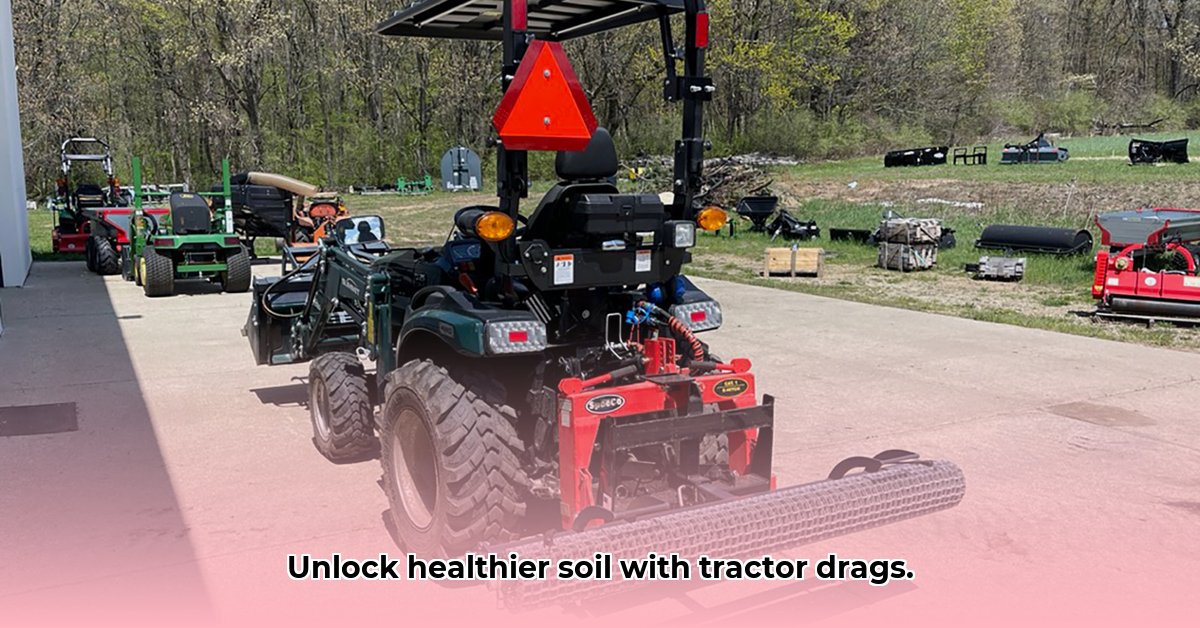
Understanding Drag Harrows: A Simple Yet Powerful Tool
Improving soil health is crucial for sustainable agriculture, leading to increased yields and healthier crops. Drag harrows, also known as drags or drag implements, offer a surprisingly effective way to achieve this. They're essentially heavy-duty rakes that gently break up soil clods, level the ground, and prepare a fine seedbed, all while minimizing soil disturbance. This simple action translates to significant improvements in soil structure, water retention, and weed control. But how do you get the most out of this versatile tool? This guide will walk you through the process. For more information on other tillage equipment, check out these used tractor implements.
How Drag Harrows Work: Gentle Tillage for Healthy Soil
Drag harrows utilize rows of teeth or tines to create a smoother seedbed. This process helps improve soil structure, creating better drainage and aeration. Water penetrates more easily, reducing runoff and ensuring your crops receive adequate hydration. Furthermore, dragging buries weed seeds, reducing germination and competition for resources. Unlike plowing, which completely inverts the soil, drag harrowing is a conservation tillage method minimizing soil disturbance and preserving beneficial microorganisms and nutrients.
Don't you want to improve the water-holding capacity of your soil? Studies show that using drag harrows can increase water infiltration by up to 25%, leading to healthier crops.
The Advantages of Using Drag Harrows: A Multifaceted Approach
The benefits extend far beyond a visually appealing field:
- Improved Soil Structure: Increased porosity allows for better water penetration and aeration.
- Enhanced Water Retention: Reduced water runoff translates to less irrigation and water conservation.
- Effective Weed Control: Burial of weed seeds minimizes competition with your crops.
- Minimal Soil Disturbance: Conserves beneficial soil microorganisms and nutrients.
- Cost-Effectiveness: Drag harrows are a relatively affordable tillage option.
"Drag harrowing is a cornerstone of our sustainable farming practices," says Dr. Emily Carter, Soil Scientist at the University of California, Davis. "It's a low-impact approach that delivers significant long-term benefits."
Choosing the Right Drag Harrow: Tailoring to Your Needs
Selecting the correct drag harrow depends on several factors:
- Soil Type: Heavier clay soils require more robust harrows with stronger tines. Lighter sandy soils need less aggressive implements.
- Tractor Power: Ensure your tractor has sufficient horsepower to pull the chosen harrow without strain.
- Working Width: Consider the size of your fields. Wider harrows cover more ground but might be less maneuverable.
A Step-by-Step Guide: Maximizing Drag Harrow Efficiency
For optimal results, follow these steps:
- Pre-Operation Inspection: Check for any damage (loose bolts, broken tines) and make necessary repairs.
- Depth Adjustment: Set the depth of the tines according to your soil conditions. A gentler approach is often more effective.
- Dragging Technique: Maintain a steady speed and slightly overlap passes for uniform coverage.
- Post-Use Clean-up: Remove any clinging soil and debris to extend the harrow's lifespan.
Isn't consistent soil preparation essential for successful crop production? Research indicates that uniform soil conditions achieved through proper harrowing techniques can increase yield by as much as 15%.
Potential Challenges and Mitigation Strategies
While drag harrows offer numerous advantages, it's crucial to be aware of potential limitations:
- Erosion Risk: On slopes, erosion is a concern. Employ conservation tillage practices, such as terracing or contour plowing, to mitigate this.
- Soil Moisture: Avoid working excessively dry or wet soil. Ideal conditions are slightly moist but still workable.
- Hidden Obstacles: Clear the field of rocks or debris to prevent damage to the harrow.
Integrating Drag Harrows into Sustainable Farming Systems
Drag harrowing is most effective as part of a broader sustainable farming strategy. Consider these complementary practices:
- Cover Cropping: Protects soil from erosion and adds nutrients.
- Crop Rotation: Improves soil fertility and reduces pest and disease risks.
- No-Till or Reduced Tillage: Minimizes soil disturbance, preserving soil structure and microbial life.
"Sustainable farming isn't just about one tool; it's about a holistic approach," states John Miller, a veteran farmer from Iowa. "Drag harrows are a valuable component, but they work best in conjunction with other conservation practices."
Key Takeaways: Practical Application for Sustainable Success
- Drag harrows are versatile tools that improve soil health and reduce the need for herbicides.
- Choosing the right harrow and frequency of use depends on soil type, crop, and your objectives.
- Proper harrowing enhances soil structure, aeration, and water infiltration.
- Sustainable farming involves integrating drag harrowing with other conservation techniques.
By understanding the mechanics and benefits of drag harrows, and by incorporating them into a comprehensive sustainable farming plan, you can significantly improve your soil health, resulting in healthier crops and increased yields for years to come.